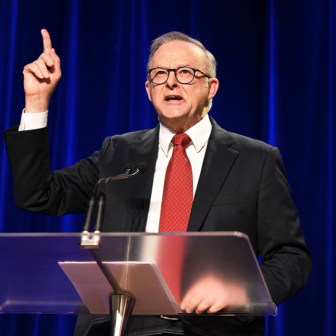It’s refreshing to learn that treasurer Jim Chalmers is willing to entertain more substantial tax reforms than the ones Labor took to this year’s election (principally, the proposed increases in taxation of superannuation balances worth more than $3 million) in order to “ensure that the budget is put on a sustainable footing.”
It has been evidence since the last budget of former Coalition government, presented by treasurer Josh Frydenberg in March 2022, that federal government spending is likely to be permanently higher, by between 1.5 and 2 percentage points of GDP, over the next decade than the average that prevailed between the end of the Whitlam years and the onset of the Covid-19 pandemic.
There are three reasons for that:
• Voting patterns and widespread support for increasing government expenditure on a variety of programs suggest the public wants more spending on health, the aged, disability and childcare.
• There is a bipartisan consensus that, whether the public wants it or not, they are going to get more spending on defence.
• The $600 billion increase in net debt since the onset of the global financial crisis and the projected $391 billion further increase in net debt over the next decade mean there is unavoidably going to be more spending on interest.
Some combination of expenditure restraint and additional revenue will be required. It’s far from obvious that this additional spending can be sufficiently offset by cuts to spending in other areas of the budget (although scrapping the obscene Western Australian GST deal — which was most recently estimated to cost $60 billion over the eleven years to 2029–30 — would be a very good step in that direction).
So what could the treasurer contemplate, if he is serious about raising additional revenue, of between 1 and 2 percentage points of GDP, in order to pay for this additional spending and put the budget on a sustainable trajectory, in the fairest and least economically damaging way?
In principle, one of the first cabs off the rank should be an increase in the rate and a broadening of the base of the GST. Australia’s GST contributes only 12.5 per cent of total taxation revenue, less than every other OECD country except the United States, which doesn’t have a GST, and well below the OECD average of 20.75 per cent.
Australia’s GST rate of 10 per cent is (along with Japan’s) lower than all but two (Canada and Switzerland) of the OECD countries with a GST-type tax, and well below the OECD average rate of 19.2 per cent: twenty-three out the thirty-seven OECD countries have standard GST rates of 20 per cent or higher (although many of those countries apply lower rates to “essential” items like food and, more recently, energy). Australia’s GST only applies to 50 per cent of total final consumption expenditure, less than in twenty-six of the thirty-seven OECD countries with a GST, below the OECD average of 58 per cent, and well below New Zealand’s 96 per cent.
As a practical matter, however, no federal government is ever going to wear the political odium of raising the rate or broadening the base of the GST, and the financial burden of compensating up to one-third of all households for the impact of doing so on them, while state and territory governments get to spend the resulting additional revenue, as would occur under our present system, which allocates all the revenue from the GST to them.
So the “nexus” between GST revenues and federal “untied” grants to the states and territories would need to be broken before this, otherwise highly desirable, reform, could be implemented.
In that context, it’s worth remembering that among the reasons why the Howard government decided to allocate the revenue from the GST to the states — apart from as an incentive for them to abolish a number of inefficient state taxes — were, first, to absolve the federal government of having to make an annual decision as to how much to give the states and territories by way of financial assistance grants (a decision which would inevitably be greeted with howls of protest by premiers and chief ministers); and second, to allow the Howard government subsequently to pretend the revenue from the GST wasn’t a federal revenue, and payments of that revenue to the states and territories weren’t a federal expenditure. This meant both could then be excluded from the federal budget, thereby allowing his government to claim it was the lowest-taxing and spending government since the 1970s. That fiction wasn’t corrected until the 2008–09 budget.
There is one major objection to collecting more revenue from the GST — namely, that it’s potentially regressive because lower-income households spend a larger proportion of their income, and hence would be proportionately more affected by an increase in the rate of GST than higher-income households.
That’s a legitimate concern. One way of addressing it, which is quite common in European countries where the standard rate of VAT is much higher than Australia’s GST, is to have lower rates on “essential” items. It’s also worth noting that many of the items currently exempt from GST in Australia, such as private health insurance premiums and private school fees, constitute a larger proportion of the spending of higher-income households than of lower-income ones — so broadening the base of the GST would not necessarily be regressive.
But in order to sell an increase in the rate and/or broadening of the base of the GST, it would seem sensible — as well as being justified on other grounds — to include some progressive tax reforms in any comprehensive reform package: that is, measures that have a larger impact on higher-income households than on lower- income ones.
It’s worth noting that, according to the latest available (2022–23) taxation statistics from the ATO, 45 per cent of the income reported by taxpayers in the top tax bracket was in forms other than wages and salaries or interest, compared with 18 per cent of the taxable income reported by taxpayers who weren’t in the top tax bracket. Equally notable is that income in forms other than wages and salaries made up just over 72 per cent of the income reported by people aged sixty-five or over, as against less than 21 per cent of the income reported by people aged between eighteen and sixty-five.
That’s significant, because income in forms other than wages and salaries can often be channelled through other structures (such as businesses or trusts) to achieve a lower tax rate. Owner-occupied housing and superannuation are very lightly taxed relative to other forms of savings and income paid out of superannuation funds in the “retirement phase” isn’t taxed at all.
So the concessional treatment of income in forms other than wages and salaries or interest disproportionately benefits higher-income and older households, at the expense of lower- and middle-income, and younger households.
And that in turn suggests a “progressive” reform of the income tax system, justifiable in its own right, but especially as a counter-balance to an arguably “regressive” increase in the GST, would be to reduce the generosity of the tax treatment of these other forms of income, compared with that of wages and salaries or interest. That could be done, for example, by reducing the 50 per cent tax discount on capital gains, curbing negative gearing, taxing trusts as companies, or taxing payouts from superannuation funds.
Alternatively, it could be achieved by adopting the schedular system used in Nordic countries, under which income from capital is taxed at a flat rate with no tax-free threshold.
In order to make those changes more politically saleable, an appropriate quid pro quo could be a significant increase in the threshold at which the top rate of income tax becomes payable. Australia’s top personal income tax rate (of 47 per cent, including the Medicare levy) is in the middle of the range for OECD countries. But the threshold at which it becomes payable — just 1.7 times average annual earnings — is very low by OECD standards.
Depending on how much additional revenue was produced by reducing the concessional tax treatment of non-labour income and by raising the rate or broadening the base of the GST, it could be possible to reduce the marginal income tax rates paid by lower- and middle-income earners.
And the tax scales should be indexed for inflation, as is done automatically in seventeen OECD countries. Particularly sensible is Westpac chief economist Luci Ellis’s proposal that income tax thresholds should be increased annually by 2.5 per cent (the mid-point of the Reserve Bank’s inflation target range), so that when inflation is above (below) the target band, fiscal policy is automatically tightened (loosened), which would take some of the burden of responding to fluctuations in inflation off monetary policy and dampen swings in interest rates.
In addition to making a meaningful contribution to “budget repair” and improving the equity of Australia’s tax system, tax reforms that seek to increase incentives to work (through reductions in tax on labour income) and to invest in income-generating assets rather than assets whose primary purpose is to produce capital gains (that is, speculation) could also contribute to the goal of improving Australia’s productivity performance. •
This is an extract from Saul Eslake’s new paper for the Australian National University’s Tax And Transfer Policy Institute. The full paper, with graphs, also looks at company taxation; taxes on “economic rents” (including revenue from fossil fuel exports) and inheritances; and state and territory taxes.




